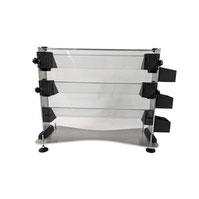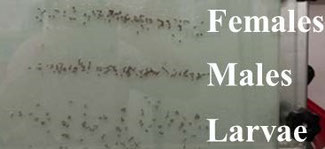Insect Pupae and Larvae Size Separator
A successful application of the sterile insect technique and other strategies designed to eliminate large populations of insects relies on the efficient releases of competitive, sterile males into the natural habitat of the target species. As released sterile females do not contribute to the sterility of a population in situ, systems for the separation of male from female individuals are needed. This is especially key for vector-transmitting species like mosquitoes, in which only females bite and transmit diseases. While several genetic and transgenic approaches have been developed that permit male-female separation for some species, separation based on sexual size dimorphism continue to be a useful technique in the laboratory and in small to medium mass rearing settings for elimination of females at the pupae stage.
IR-604 - 3-step mosquito size separator

IR-604 Insect Sex Separator, designed to separate insect pupae and larvae into three size classes. In general, female mosquitoes of many species such as Aedes and Culex, but also Anopheles quadrimaculatus and A. albimanus are larger than males in the pupal stage. In addition to separating pupae by sex, the device can be used to separate pupae from the remaining larvae (see tray and rack rearing system). Separation sizes are set by adjusting the slit width of narrow glass plates against a glass backplate. Our model is thus based on the classical larval-pupal separator (narrowing glass plates, Fay-Morlan glass plate separator), but with a more convenient and efficient entry and washing/collection mechanism and three stages of separation - in particular allowing more accurate fractionation of populations with some overlap between sex sizes (e.g. smaller than usual females and larger males). In addition, because pupation is spread over time, it is necessary to separate pupae from the remaining larvae. Specimens are fed into the IR-604 from the top in an aqueous solution, which effectively transports the individuals either to the removable collection basket at each level or to a lower level (if smaller than the set slit width); the slope towards the basket is set by height adjustable feet. See the pdf document below for details/specifications of the IR-604 Pupae Sex Separator and a brief instruction manual. The IR-604 may also be used to separate pupae / larvae of other insect species if the individuals are i) in an aqueous solution and ii) have an explicit size dimorphism.
IR-604 Insect Sex Separator - Features
- Effective separation of pupae / larvae into three size classes
- User adjustable size classes
- Adjustable feet to set a slope towards the removable collection baskets
- Easy to clean
Size Dimorphism in Insects & Methods to Separate Insect Pupae by Size

Size dimorphism in insect larvae and pupae refers to the presence of size differences between males and females of a species. In many insect species, such as A. aegypti (see example image), females are larger than males, a phenomenon known as "sexual size dimorphism". However, since not all larvae in the mass rearing trays become pupae at the same time, it is also necessary to separate the larvae from the pupae - so that the larvae can continue to be reared while the pupae are transferred to mass rearing cages for reproduction, or used for release in SIT, etc.
- Here are some key points about size dimorphism in insects: Read more
-
- Causes: The causes of size dimorphism in insect larvae and pupae are not allways fully understood, but are likely to be related to differences in mating behaviour, reproductive strategy and ecological factors. For example, larger females may have a competitive advantage in mating or may be better equipped to produce larger eggs.
- Developmental differences: Size dimorphism in insect larvae and pupae may be the result of developmental differences between males and females. For example, females may have a longer larval or pupal stage than males, allowing them to grow larger.
- Morphological differences: In some insect species, females have different morphological characteristics than males, which can lead to size dimorphism.
It is important to note that rearing conditions can influence the extent of size dimorphism in insect pupae. Nutrition is one key factor that can influence size dimorphism in insects - rendering a standardized feeding process imperative. Inadequate nutrition can lead to smaller body size, different feed application per tray will likely lead increased size heterogeneity and thus complicate sorting. Other environmental factors that can influence size dimorphism in insect pupae include temperature, humidity, and/or photoperiod. For example, low temperatures can slow insect development, while high temperatures can accelerate development. In addition, social factors such as crowding can also influence pupal size dimorphism. Crowding can lead to increased competition for resources, resulting in smaller or more heterogeneous body sizes.
In summary, rearing conditions, including diet, temperature, humidity, photoperiod, and social factors, can all influence the extent of size dimorphism in insect pupae. In order to exploit size dimorphism to separate insect larvae or pupae using a size separator such as the IR-604 (or other methods, as illustrated below), it is therefore essential to maintain constant and optimized (diet, temperature, etc.) rearing conditions, e.g. in standardized rearing tray and rack systems, leading to most homogeniously sized larvae and pupae (per sex).
- There are several methods that can be used to separate insect pupae by size. Here some of the more common methods are given: Read more
-
- Sieving: Sieving is a simple and effective method of separating pupae by size. Pupae are poured into a sieve with a mesh size appropriate to the size range desired and the sieve is shaken or agitated to separate the larger pupae from the smaller ones. The separated pupae can then be collected and sorted as required. However, the mechanical stress on the pupae by sieving is high, resulting in frequent damage.
- Narrow plates: The narrow plate method, also known as Fay–Morlan glass plate separator, as used in the VSI IR-604 sex separator (see above), is another technique that can be used to separate insect pupae by size. Here a narrow plate of plastic, glass or metal forms a (an increasingly narrow) slit or slits of a specified width against another part. The width of the slit/slits can be chosen according to the desired size range of the pupae to be sorted. The mechanical stress on the pupae by narrow plate techniques is generally low, resulting in few damaged pupae.
- Density separation: This method separates pupae according to their density. Pupae are placed in a solution of a given density and the solution is then centrifuged or allowed to settle; partially iced water has been used to create density differences in a container. The larger and heavier pupae settle to the bottom, while the smaller and lighter pupae remain suspended in the solution. The separated pupae can then be collected and sorted. There is generally no mechanical stress to the pupae (unless centrifuged).
- Hand sorting: Hand sorting is a labor intensive but most effective method of separating pupae by size. Pupae are visually inspected and manually sorted into different size categories. This method is often used for small-scale rearing or research projects. Hand sorting is also necessary to select screen sizes and slit widths prior to, and to verify sorting accuracies after, using any of the above methods.
Overall, the choice of method for sizing insect pupae depends on the insect species, particularly the size range between large and small fractions, the resources and equipment available, and the volume of pupae to be sorted. The effectiveness and efficiency of each method should be evaluated and compared to determine the optimal approach for the specific application. Vienna Scientific is ready to assist in the design of automated, effective sorting systems, please get in contact.
| References | Mechanical Separation and Size Dimorphism of Insects | OPEN |
|
||
The IR-604 Insect Size Separator is often used with Mosquito Tray and Rack Mass Rearing Systems, where the separation of large quantities of male and female pupae and residual larvae is a standard task.







